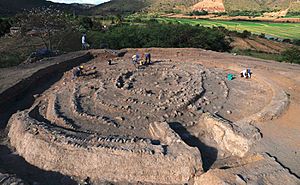Montegrande (archaeological site) facts for kids
 |
|
| Coordinates | 5°42′57″S 78°47′37″W / 5.71583°S 78.79361°W |
|---|---|
| Type | settlement |
| Area | 2 acres |
| History | |
| Founded | 3000 BCE |
| Cultures | Mayo-Chinchipe |
| Site notes | |
| Archaeologists | Francisco Valdez (Ecuador) Quirino Olivera (Peru) |
Montegrande is an ancient archaeological site in Peru. It is located in the Cajamarca region, in the Jaén province. This site features a special spiral-shaped temple or building. It was built around 3000 BCE. This means it is about 5,000 years old! That makes it as old as Caral, another very old site in Peru. The people who built Montegrande lived in an area that is now split between Peru and Ecuador.
Contents
Discovering Montegrande
Archaeologists started digging at Montegrande in 2009. Money for the project came from the Andean Community. The team included experts from both Ecuador and Peru. Francisco Valdez led the Ecuadorian archaeologists. Quirino Olivera was in charge of the Peruvian team.
Before these digs, people thought sites like Montegrande were just hills. They believed the later Bracamoros culture had left some remains on top. No one expected to find such old buildings in the Peruvian jungle. An archaeologist named Julio C. Tello had suggested in the 1920s that Andean culture might have started in the Amazon rainforest. But other researchers did not agree with him at the time.
What the Digs Found
When archaeologists first started working at Montegrande, it was a mess. There was a half-built Catholic church on top of the hill. The area had also become a dump and a place where people smoked. The team cleaned up the site and removed all the modern buildings.
They first found yellow steps and floors. Then, they removed a layer of clay and small stones. Underneath, they found an amazing spiral building. They also found the bones of a man. It seems he was sacrificed before the building was finished.
Other Important Discoveries
The archaeological project also made exciting finds at other sites.
- At San Isidro, they found a burial site for an important person.
- In Casual and Las Juntas, they discovered colorful wall paintings. These paintings were different from those found in mountain or coastal cultures.
- In Ecuador, at the Santa Ana-La Florida site, they found another spiral building. It was very similar to the one at Montegrande.
- They also found the tomb of an important person there.
- Most excitingly, they found proof of cocoa farming. This cocoa was grown between 5,500 and 5,350 years ago. This is 1,500 years older than any cocoa found before in Mexico. Before this discovery, people thought cocoa farming began in Mesoamerica.
The Spiral Building
The spiral building at Montegrande is made from adobe (sun-dried bricks) and round stones. Experts believe it was a special temple used for ceremonies. They think an important person was buried beneath it. This person might have been a healer or a priest. This idea comes from what they found at the sites in Palanda and San Isidro.
Meaning of the Spiral
Spirals seem to have been very important to the beliefs of ancient Andean people. Archaeologists think the spiral shape represents a coiled snake. This snake symbol also appears at other nearby ancient sites.
The spiral shape can also be seen in the famous Nazca Lines. For example, the monkey geoglyph is a spiral. The shape is also like a snail or the Spondylus shell. These shells came from the coast of Ecuador. They have been found in Jaén and Bagua. This shows that people traded goods between these different areas long ago.
See also


